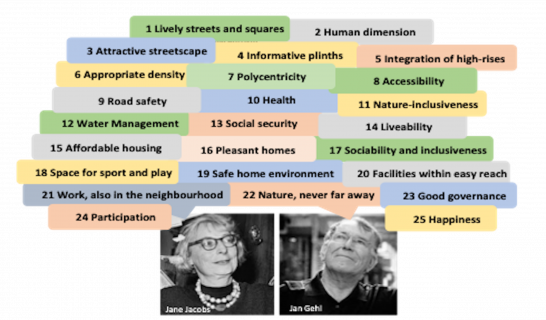This article is the introduction to the series 25 building blocks for better streets, neighbourhoods and cities, which you can read every Tuesday and Friday starting next week. The link below refers to an overview of all upcoming posts.
It often strikes me how much people agree about the quality of the living environment. Many, especially younger ones, prefer a house built in the '30s. Older neighbourhoods almost always score higher than modern ones, due to the alleged lack of atmosphere, sociability, and intimacy in the latter. Urban planners, architects and politicians would like to change this, and they are doing so. Slowly.
In urban planning a breeze of fresh air comes in.
How cities in Europe currently look stems largely from the ideas of Le Corbusier through his role in the Congrès Internationaux d'Architecture Moderne (CIAM). The Dutch architect and urban planner Cornelis van Eesteren was also a prominent representative. The influence of the Congress is visible in the spacious post-war residential areas with their long rows of single-family houses and medium-rise buildings. The underlying idea was to design a functional city in which living, working, shopping and recreation all have their own separated places.
Slowly, the voice of a new generation of urban planners in which Jane Jacobs and Jan Gehl (pictures above) play a prominent role became louder. They detest post-war urban expansion and advocate mixing urban functions. 70 years after the publication of her book The Death and Life of Great American Cities, Planetizen magazine predicated urban activist Jane Jacobs as the most influential urban planner ever, even though she never studied this field. Jan Gehl, who did, follows in second place. By the way, Anne Hidalgo, the mayor of Paris, is in 7th place; not because of what she studied but of what she put into practice.
Many others, including representatives of New Urbanism, play an important role in further developing the ideas of Jacobs and Gehl. For instance, they put back on the agenda the return to the 15-minute city. ‘New urbanists’ also top the list: Andres Duany, the author of Suburban Nation at four and Jeff Speck, who authored Walkable City, at ten.
The concept of high-quality living environment
Many contemporary ideas about urban development come together in the concept of high-quality living environment. A compact definition of this concept is improving human well-being in a condensing city. I have collected and clustered references to characteristics of high-quality living environments in many recent publications into 25 building blocks. Each block deals with one aspect of the quality of the living environment, or in other words the creation of better streets, neighbourhoods, and cities. Consider this a tribute to the mission of the Amsterdam Smart City community, of which I was a curator for several years.
I hope you get inspired and support the use of these building blocks.






Great and excellent urbanists, city plannes and urban theoretics have contributed bringing the changes along our conepts to become the best pratices places for sutained cities.